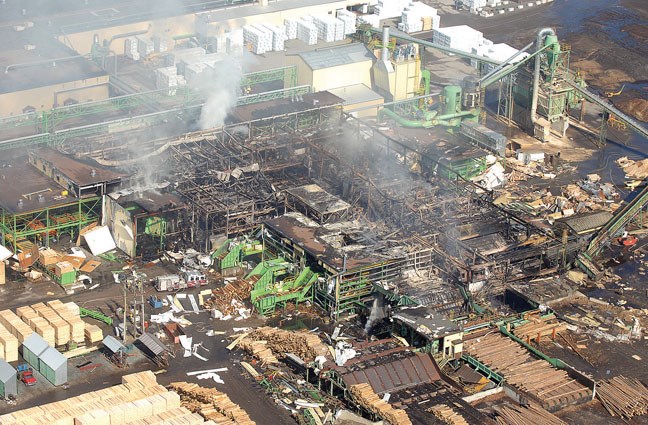The explosion that destroyed the Lakeland Mills sawmill originated in a spot where equipment not rated for use in a high sawdust area was operating, a coroner's inquest into the disaster heard Friday.
B.C. Safety Authority engineer Jeff Coleman was on the stand to present findings from that organization's investigation into the April 23, 2012 disaster that killed two employees and injured 21 others, some severely.
Coleman said the explosion's source was in the sawmill's basement directly below where the large headrig was located on the main floor, one level above. The headrig's operator, Glenn Roche, was one of the employees who died from injuries suffered in the blast.
Alan Little, a supervisor at the sawmill, was the other man who died.
Wood dust provided the fuel for the blast but investigators were unable to pin the ignition source to a single item. Rather, Coleman said it could have been any of a conveyor motor, wiring supplying power to other electrical equipment and the light assemblies in the area.
Because there was so much dust in the area, Coleman said it was not necessary for any of those pieces to malfunction to provide an ignition source. Rather, any of them could have created enough heat or spark to ignite the surrounding dust through normal operation.
Either keeping the area clear of dust or using equipment rated for use in a hazardous area would have prevented the incident, Coleman agreed when questioned by coroner's counsel John Orr.
In earlier testimony, employees said they noticed an increased amount of particularly fine and dry dust that tended to hang in the air as the sawmill processed more and more beetle-killed pine.
"I believe that the explosive nature of the materials was not fully understood," Coleman said when asked to offer an opinion on what happened.
The BCSA oversees the safe installation and operation of technical systems and equipment in workplaces, including electrical equipment and systems, although it is not responsible for mechanical equipment.
A WorkSafe BC investigation concluded a gear reducer attached to the conveyor motor was the source. It's believed the gear-reducer's fan came loose and became embedded in the steel screen covering that end of the assembly, grinding into it and coming to a stop.
The shaft continued to spin and the consequent friction created enough heat to ignite a cloud of wood dust. And since the fan was no longer turning, "the fine dust in the air could freely migrate into this immediate area, even within the shroud," the WorkSafe report says.
A WorkSafe investigator is scheduled to testify next week.
As a result of the BCSA's findings and well as those from its investigation of the explosion at Babine Forest Products on Jan. 20, 2012, which also killed two workers and injured more than 20 others, Coleman said changes are being made.
They include specifically identifying wood dust as a combustible material, similar to coal and grain dust, in the electrical code, and designating spots where there are high concentrations as hazardous areas where only rated equipment can be used.
Following the blasts at Babine and Lakeland, Coleman said the BCSA issued a safety order requiring sawmills to either clean up trouble spots or install equipment rated for use in those areas.
BCSA inspectors subsequently visits all 237 wood processing facilities in the province and 140 are slated for followup visits this year, Coleman said. The BCSA employs about 150 inspectors based in offices across the province.
Under the right conditions, even the sparking from the contact point at the end of a flourescent light could ignite a fire, Coleman said. It appeared that powerful halide light bulbs, which provide an intense heat, were also in use, according to the BCSA report.
The inquest, which is expected to last at least another two weeks, continues Monday at the Prince George courthouse, 9 a.m. start. In all, 36 witnesses are expected to testify, down from the 47 originally scheduled, and six-man jury will be asked to make recommendations to prevent similar incidents from occurring in the future.



